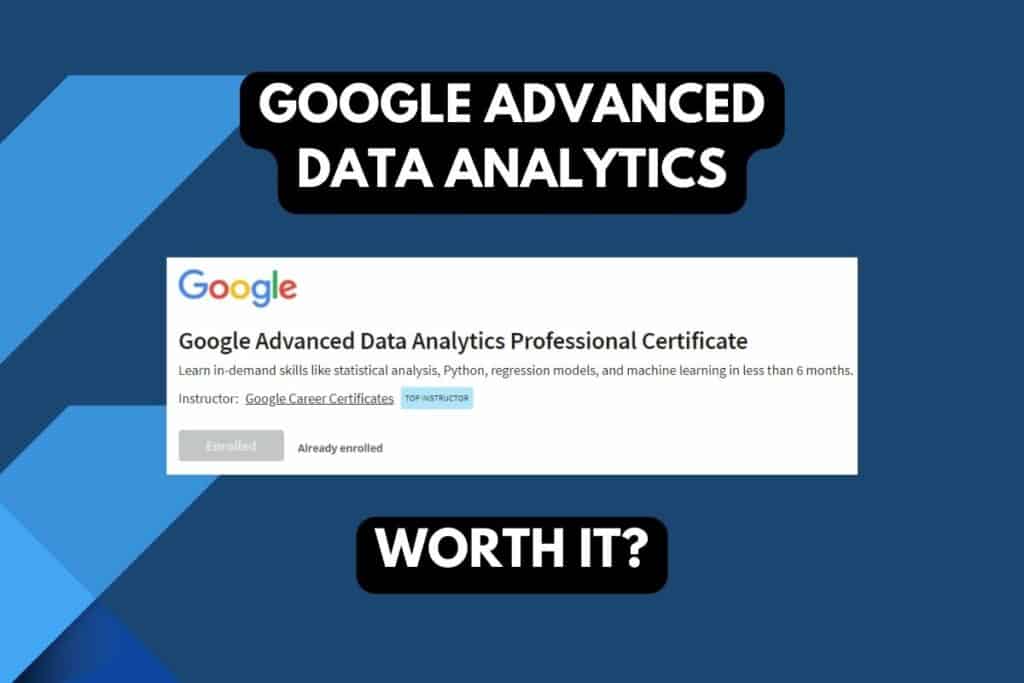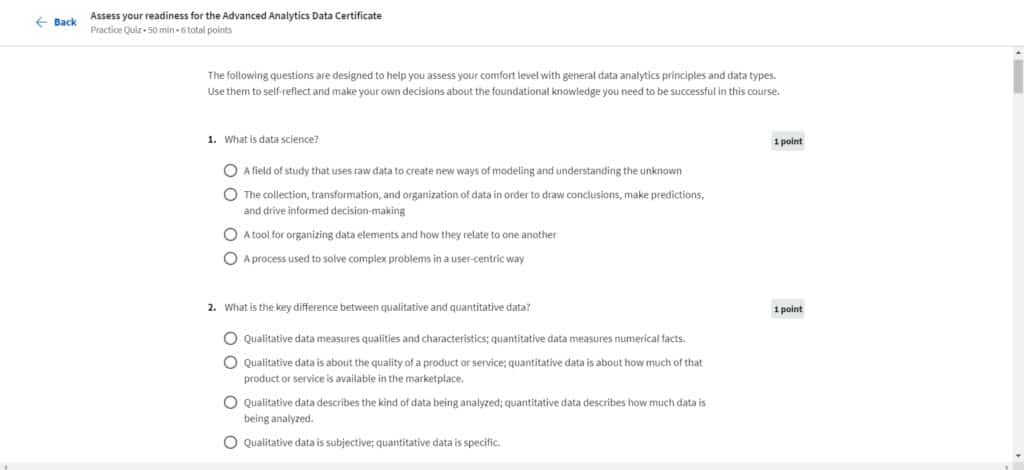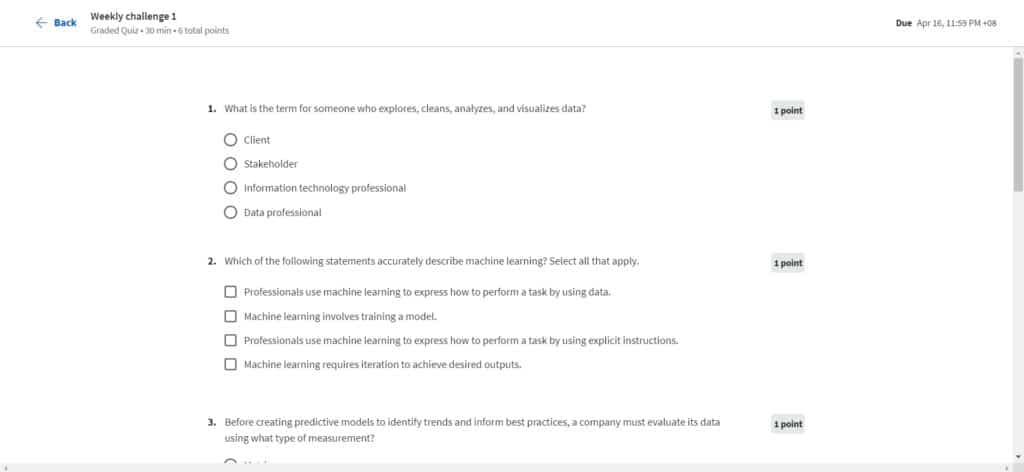This post may contain paid links to my personal recommendations that help to support the site!
So you’ve recently completed the original Google Data Analytics Certification. And you’re likely wondering—what’s next?
Or you might have already entered the data industry through the basic Google data analytics certificate and would like to advance your skills further.
Well, then, the Google Advanced Data Analytics Professional Certificate might be perfect for you!
However—is it that worth it?
In this blog post, I’ll give you my verdict of the certificate, an overview of the courses, and provide my input on them as a data analyst! I’ll also cover some common related questions too.
Read on to find out more!
Google Advanced Data Analytics Professional Certificate: My Verdict

The Google Advanced Data Analytics Certification is worth it. The certificate offers over 200 hours of content on machine learning, data visualization, statistics, and predictive modeling using Python at an affordable total cost of $147.
Now, why do I say that it’s worth it?
Let me run you through what the certificate is, as well as the content provided in the courses, to help you understand why!
I’ll also include my opinion, which I’ll expand more on later after each point!
What is Google Advanced Data Analytics Certification?
The Google Advanced Data Analytics Certification is a self-paced, online 7-part course program on advanced data analytics skills designed by Google.
Designed for advanced data analytics professionals, this certificate focuses on machine learning, predictive modeling, and statistics.
This certificate is higher than the original Google Data Analytics Certification regarding difficulty and is not meant for pure beginners.
The certificate also includes a Capstone Project at the end of all the courses.
What Can You Expect to Learn From this Certificate?
You can expect to learn about several aspects required of a senior data analyst, data science analyst, or junior data scientist.
Some common skills you’ll learn include:
- Python programming and applying it to create predictions
- Data exploration, cleaning, and preparation
- Statistics and machine learning concepts (regression models)
- Data visualization using Tableau
- Exploratory Data Analysis (EDA)
- Technical interview preparation
- Data analytics portfolio building
To help you acquire these skills, you’ll be guided along the way to pick up some useful data analytics tools as well.
I like that the certificate provides ungraded quizzes just to check in on my learning! I personally love to learn through active recall, and these quizzes are a big help.

Here’s a list of tools you’ll learn:
- Python
- Jupyter Notebook
- Tableau
- Kaggle
Although this list might seem a little short, there will be lots of Python practice up to intermediate and advanced levels so that you won’t miss out on learning.

Your knowledge of these tools as well as concepts will be tested through simple graded weekly challenges in the form of multiple-choice questions. This is perfect for those who want a more structured learning approach.
How Long Does it Take to Complete the Certificate?
It takes three months to complete the Google Advanced Data Analytics Certificate. Although Google suggests completing it within six months at a pace of fewer than 10 hours per week, most intermediate learners can complete it much faster.
This highly depends on the amount of previous programming and data experience.
Other factors, like your commitment to completing all exercises, also affect the completion duration.
How Much Does the Certificate Cost?
The Google Advanced Data Analytics Certification costs $147 to complete. This is based on a subscription of $49/month and an average of 3 months of completion time.
Do note that the certificate is also included in any Coursera Plus Subscription, which can help you save on costs too. Also the certificate also has a free 7-day trial before the billing cycle begins.
Therefore, the cost of the certificate goes down the faster you complete it!
Coursera Plus is a subscription that unlocks access to over 7000 courses with just a single cost. The subscriptions are available for monthly and yearly billing. My yearly subscription has helped me complete several certifications at a flat fee, so it’s well worth it!
Plus, there are more cost savings for a yearly subscription too.
Google Advanced Data Analytics Certificate Content Review
Now, let’s dive deeper into the content of this certificate and find out what you’ll be learning in each course.
1. Foundations of Data Science
First up, you’ll be given an introduction to the world of data science and analytics.
Here’s a list of topics covered and their respective completion times:
- Introduction to data science concepts (5 hours)
- The impact of data today (4 hours)
- Your career as a data professional (3 hours)
- Data applications and workflow (6 hours)
- Course 1 end-of-course project (3 hours)
This course provides a context in which most of the data work lies.
Also, in contrast to the course title, most concepts taught here aren’t specific to data science. So don’t worry!
You’re still on the right track to learning about the data analytics field.
My Take on This Course:
This Foundations of data science course seemed like an introductory exploration of concepts in the data world. If you’re already in the field like me and have several years of experience, this section can be pretty redundant.
However, if you like having some additional background on more advanced analytics roles, this course is still worth taking.
Also, take note that this course doesn’t teach any technical content at all!
One thing I really agree with in this course is the emphasis on creating a data analyst portfolio.

As you can see in the lecture screen capture above, the course instructor recommended learning by doing. This is absolutely essential in crafting an effective portfolio!
2. Get Started with Python
Once you’ve cleared the first course, the certificate dives right in to help you pick up a new programming language—Python!
Here’s a list of the topics covered and their completion times:
- Hello, Python! (5 hours)
- Functions and conditional statements (4 hours)
- Loops and strings (5 hours)
- Data structures in Python (6 hours)
- Course 2 end-of-course project (4 hours)
Through this course, you’ll pick up the basics of Python through a data analytics-focused approach. This would all be done through an integrated environment on the Coursera platform.
The tool you’ll be using this time is the Jupyter Notebook.
My Take On This Course:
Finally, a breath of fresh air from all the dry topics, you’ll be getting your hands dirty from programming in this course.
And if you’ve been in tech, you’re sure to know the importance of practical experience when learning new tools.
I really liked how Google focused on teaching Python this time instead of R on the original Google DA Cert.
That’s because Python is so much more widely-used and appropriate for machine learning applications further down.
Since this is an advanced certificate, Python makes an excellent choice for data analytics.
Moreover, the labs given on the Coursera platform were great for learning step-by-step. Having a Jupyter Notebook environment to learn in is perfect for those new to Python to get familiar with common data science tools.

The first Google Data Analytics Certification did not have such integrated labs for learning R, so these labs are a much-needed upgrade!
3. Go Beyond the Numbers: Translate Data into Insights
In this next course, you’ll be taught how to apply your basic Python skills to the world of data science. This means that you’ll get to further your skills in Python through exploratory data analysis (EDA).
Moreover, you’ll be able to build upon the Tableau knowledge you’ve gained from the basic Google Data Analytics Certification.
Here’s a list of the topics covered and their completion times:
- Find and share stories using data (3 hours)
- Explore raw data (8 hours)
- Clean your data (8 hours)
- Data visualizations and presentations (5 hours)
- Course 3 end-of-course project (4 hours)
My Take On This Course:
I really like the practical aspects of using Python to handle raw data. The exercises were also helpful in going through the necessary steps to extract and load data within a Jupyter Notebook—which I often did as a data analyst.
Having Tableau as a data visualization software was good, but I had already learned that in the first certification by Google, so I felt that this was like a repetition.
I would have preferred to learn a different tool like Power BI or to use Python data visualization libraries like Seaborn or Plotly.
However, overall, this course still provides good practice for data cleaning, data transformation, and data visualization.
The end-of-course project was a good bonus to solidify my learning of Python and Tableau too!
4. The Power of Statistics
The fourth course delves more into statistics and how the tests can be implemented in Python.
Here’s a list of the topics covered and their completion times:
- Introduction to statistics (6 hours)
- Probability (7 hours)
- Sampling (6 hours)
- Confidence intervals (4 hours)
- Introduction to hypothesis testing (6 hours)
- Course 4 end-of-course project (4 hours)
My Take On This Course:
I believe I gained the most value from this course! Being taught statistics formally was something I had always needed since I had come from a non-data analytics background.
Having Google employees share their experiences and explanations of different statistical concepts was really refreshing.
I really enjoyed how the statistical analysis was highly practical and transferrable to Python too. That made things feel a little less dry and boring.
This course would be pretty useful for digital marketing analysts who would be using A/B and hypothesis testing most often in analyzing marketing campaigns too.
5. Regression Analysis: Simplify Complex Data Relationships
Having a basic foundation in statistics, you’ll be taken into the world of machine learning through supervised learning algorithms first.
This is where you’ll get familiar with two main algorithms: Linear and Logistic Regression.
Here’s a screenshot I took of one of the video lectures explaining the linear regression model.

Here’s a list of the topics covered and their completion times:
- Introduction to complex data relationships (3 hours)
- Simple linear regression (7 hours)
- Multiple linear regression (5 hours)
- Advanced hypothesis testing (4 hours)
- Logistic regression (5 hours)
- Course 5 end-of-course project (5 hours)
Through these courses, you’ll understand the basic steps on how to approach a problem by using regression models, followed by implementation and interpretation, all using Python.
My Take On This Course:
I thoroughly enjoyed the experience of re-learning these basic machine learning algorithms since they were so easily digestible compared to the other previous online courses I learned from. These were much better than the ones taught by IBM, in fact.
Once again, the end-of-course project was a good way for me to summarize my learning.
6. The Nuts and Bolts of Machine Learning
In this last lecture-focused course of the certificate, you’ll be learning common machine learning algorithms and how data professionals use structured workflows for the entire process.
Here’s a list of the topics covered and their completion times:
- The different types of machine learning (5 hours)
- Workflow for building complex models (7 hours)
- Unsupervised learning techniques (5 hours)
- Tree-based modeling (12 hours)
- Course 6 end-of-course project (5 hours)
My Take On This Course:
This course is highly relevant if you’re a data analyst that’s striving to become a junior data scientist. Having a good grasp of common algorithms like k-means clustering, random forest, and Naive Bayes has helped me in my work as a data scientist too.
Therefore, I really like the lineup of technologies you’ll learn here.
However, deep learning was only introduced briefly without much in-depth explanation. I was expecting more of such topics since this certificate was supposed to prepare for advanced analytics topics.
Nonetheless, this should be sufficient for more junior roles!
7. Google Advanced Data Analytics Capstone
This final course focuses more on encouraging you to complete a capstone project and providing career resources than content.
Here’s a list of the topics covered and their completion times:
- Capstone Project (5 hours)
- Data-focused career resources (4 hours)
- Put your Advanced Data Analytics Certificate to work (1 hour)
This course provides you with an option to take up a capstone project. The capstone project objective and dataset are provided for you to try at your own pace. However, the project is optional.

In the capstone project given, you’ll be working on a task to provide data-driven insight for human resources in a mock company called Salifort Motors.
The remainder of the course includes career resources and information on how to craft a data analytics resume and portfolio.
My Take On This Course:
I always enjoy working on projects since they help build personal confidence in a new tool. Therefore I’m all for this capstone project, and I strongly recommend it to all learners despite it being optional.
I would also like to bring up how they mentioned using LinkedIn to build connections for networking as a data analyst.
As I’ve personally landed a data analyst job as well as some other data analytics writing positions through LinkedIn, I’m in full support of this.
Final Thoughts
In conclusion, the Google Advanced Data Analytics Professional Certificate is an excellent choice for someone looking to understand advanced machine learning and statistics concepts through Python.
The course is well-structured and includes good practice resources, such as a capstone project, career resources, and progress-tracking tools.
All in all, this certificate program provides a great foundation for machine learning and working on real-world data science problems.
I hope this article has helped you in making the decision to get it. Thanks for reading!

